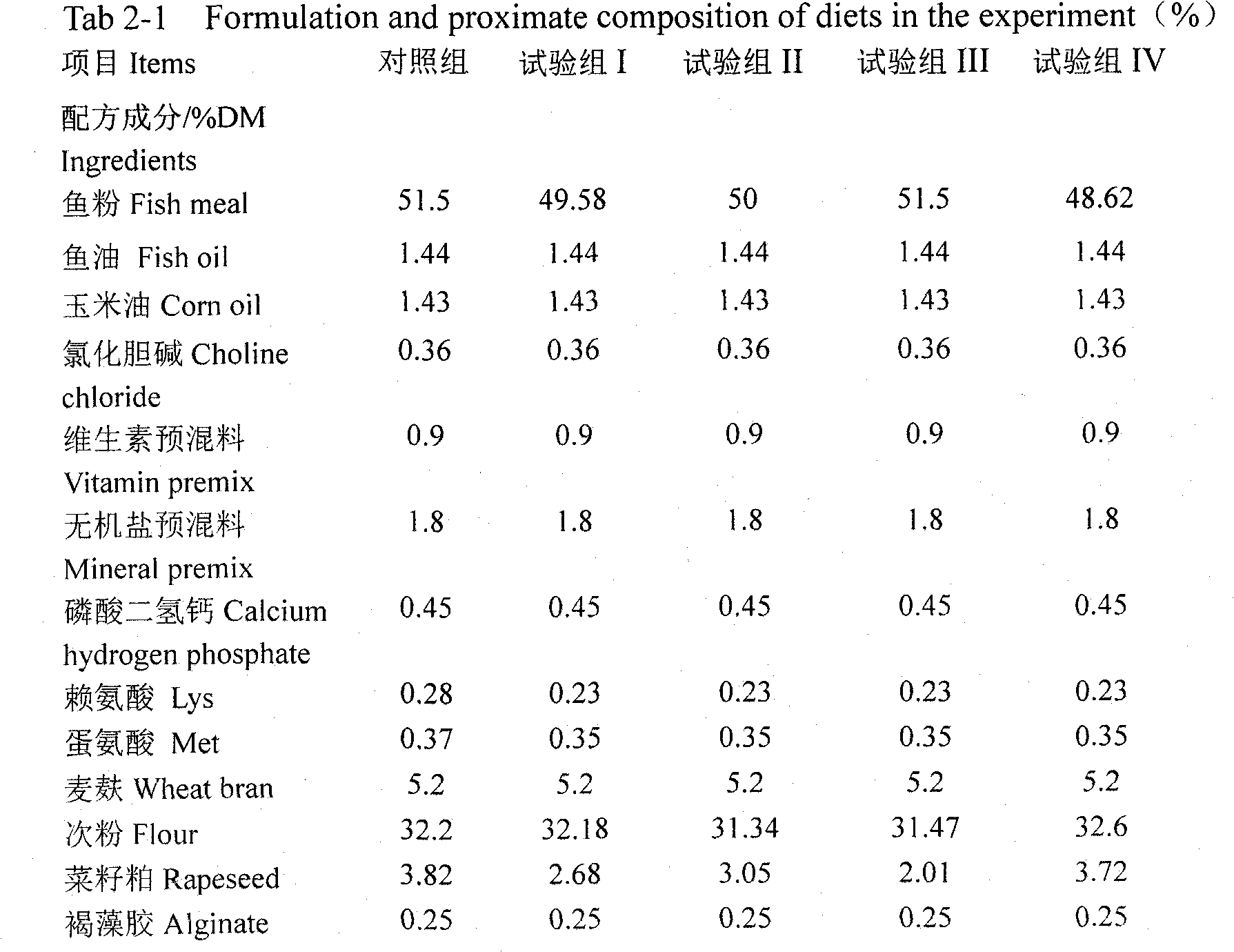Compound feed for wild carps
A compound feed and premix technology, applied in animal feed, animal feed, climate change adaptation, etc., can solve the problems of darkening body color, fat body shape, lack of color, flavor and body shape, etc., and achieve the effect of promoting growth
- Summary
- Abstract
- Description
- Claims
- Application Information
AI Technical Summary
Problems solved by technology
Method used
Image
Examples
Embodiment 1
[0012] Each component weight / % of the compound feed of Example 1 wild carp is shown in Table 1
[0013] Table 1 Feed formula and nutrient composition of the test (%)
[0014]
[0015]
[0016] Note: 1 vitamin cable premix (mg / kg feed): thiamine hydrochloride, 65; riboflavin, 215; folic acid, 16; pyridoxine hydrochloride, 42; niacin, 815; calcium pantothenate, 285; Inositol, 405; Biotin, 5; Vit E, 358; Vit B 12 , 0.12; VitA, 1.1; Vit D 3 , 0.06; Vit C, 250.
[0017] 2 Inorganic salt premix (g or mg / kg feed): magnesium sulfate heptahydrate, 1.8g; ferric citrate, 0.9g; zinc sulfate heptahydrate, 0.5g; copper sulfate pentahydrate, 7mg; trichloride hexahydrate Aluminum, 2.8mg; Potassium Iodide, 4.5mg; Sodium Selenite, 0.3mg; Manganese Sulfate Monohydrate, 5mg; Cobalt Chloride Hexahydrate, 3mg; Sodium Dihydrogen Phosphate, 7.5g; Potassium Chloride, 2.5g.
Embodiment 2
[0018] Example 2 Feeding experiment
[0019] 1) The experimental fish were from the same batch of artificially hatched one-year-old wild carp fingerlings. Before the test, they were temporarily raised in an indoor aquarium, and 1,000 juvenile fish with robust and uniform size were selected; they were acclimated in the indoor aquarium, and the control group feed with a protein content of 35% was fed as the domesticated feed, and they were fed with full food and domesticated for 15 days. ;
[0020] 2) The feeding experiment lasted for 8 weeks; 6 treatment groups were designed according to the experimental design, with 3 repetitions in each group. Before the start of the experiment, feeding was stopped for 1 d, and then wild carp species (16.81±0.54g) with strong physique and uniform size were selected and stocked randomly. In the indoor aquarium, 30 fish are stocked in each box, and the daily feeding rate is 2.5-4.0% of the body weight, depending on the size of the fish, water ...
Embodiment 3
[0022] Example 3 Determination of growth and shape indicators
[0023] Raised for 8w, fasted for 24h before sampling, and weighed each replicate separately. Calculate the average growth rate and specific growth rate (SGR), etc. Another 9 fish were taken from each group (3 fish per repetition), and the water on the body surface of the fish was drained, and the white muscle above the lateral line and below the dorsal fin was taken to determine its nutritional content. The body weight and body length of 10 tails in each group were measured for each replicate, and the plumpness and viscera-to-body ratio were calculated. The specific calculation is as follows.
[0024] Average weight gain rate (%) = 100% × (W t -W 0 ) / W 0
[0025] Visceral body ratio (VI) = visceral mass (g) × 100 / fish body mass (g)
[0026] Fullness (CF) = (W / L 3 )×100
[0027] I(g) is the dry weight of ingested feed, W 0 (g) and W t (g) is the total weight of the fish at the beginning and end, t(d) is ...
PUM
 Login to View More
Login to View More Abstract
Description
Claims
Application Information
 Login to View More
Login to View More - R&D
- Intellectual Property
- Life Sciences
- Materials
- Tech Scout
- Unparalleled Data Quality
- Higher Quality Content
- 60% Fewer Hallucinations
Browse by: Latest US Patents, China's latest patents, Technical Efficacy Thesaurus, Application Domain, Technology Topic, Popular Technical Reports.
© 2025 PatSnap. All rights reserved.Legal|Privacy policy|Modern Slavery Act Transparency Statement|Sitemap|About US| Contact US: help@patsnap.com



